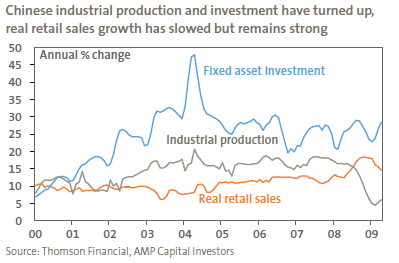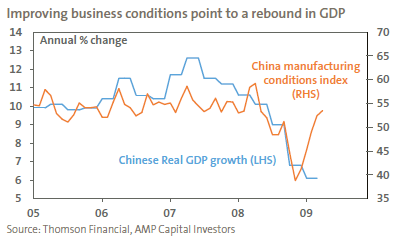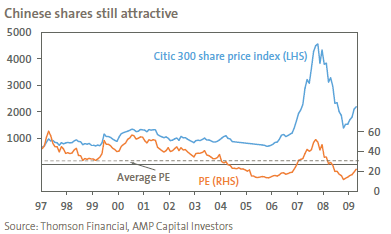China’s recovery
Key points
- China’s economy is recovering on the back of a combination of fiscal and monetary stimulus and signs the export slump is easing. It is on track for 8% gross domestic product (GDP) growth this year.
- Unlike developed countries which face structural constraints on growth, China’s low per capita consumption, low household debt levels, rapid urbanisation, low public debt and relatively sound banking system are structural tailwinds for growth going forward.
- Chinese shares have had strong gains from their lows. However they are still well below their highs and offer good long term value.
- Australia will be a key beneficiary of the domestic demand-driven recovery in China now underway.
Introduction
After slowing sharply late last year – highlighted by a slump in GDP growth from a peak of near 13% in 2007 to just 6.1% over the year to the March quarter – a range of indicators are pointing to a recovery in China. While there has been much talk of the ’green shoots‘ of recovery, globally these have been much stronger and more broad based in China. In fact, talk of a hard landing (defined as 6% or less annual growth in China) is now giving way to confidence that GDP growth this year will be around the 8% level. Talk of a recovery in China has been met with disbelief by many; the most common concern is that Chinese growth is dependent on the US consumer and if it remains weak then so too will China. This note looks at whether China’s recovery is the real thing and if so, what it means for commodity prices and Australia.
The Chinese economic cycle is turning up again
During the December quarter last year, the focus of Chinese policy makers swung aggressively towards boosting their economy in the face of the sharp downturn then underway. A massive fiscal stimulus package focused on infrastructure spending was announced, monetary conditions were eased aggressively, various industry support plans were released, the gradual appreciation of the Renminbi came to an end and policies to promote consumption were stepped up. The evidence clearly suggests that this is bearing fruit:
- Money supply and loan growth has surged higher
- Fixed asset investment has picked up to a 30% year-on-year (yoy) pace from a low around 22% in December
- Industrial production is growing again
- Real retail sales growth has remained strong

- Surveys of business conditions in both manufacturing and services sectors have improved for 5 months in a row
- Property sales are rising
- The downswing in Chinese exports appears to be abating, reflecting the stabilisation in global conditions.
The broad-based nature of the pick up in China suggests it is more than just a bounce associated with the end of the inventory destocking cycle. The improvement in manufacturing conditions points to a reacceleration in GDP growth this year.

These considerations suggest a recovery is in progress and growth is back on track to be around 8% this year.
But is it for real?
While there will no doubt be setbacks along the way, there are good reasons to believe that the rebound we are now seeing in China is sustainable. Firstly, consumer spending in China has a huge potential for strong growth going forward. Unlike in countries such as the US and Australia where consumption accounts for around 60% to 70% of GDP, in China it has fallen to less than 50%. So there is significant potential to push it back up.

Several considerations are worth noting in this regard:
- Despite common perceptions, Chinese consumption has actually been growing very strongly. It’s just that business investment and net exports have been growing faster. This reflected a combination of factors including economic policies designed to boost investment and exports, which were partly motivated by a desire to ensure China did not become vulnerable to a withdrawal of foreign capital as occurred in the Asian crisis. There are also strong levels of household savings as the social safety net was wound back last decade.
- The Chinese Government has now shifted to promoting more balanced growth with much greater emphasis on consumer spending. With the global crisis highlighting the downside of being too reliant on exports, this adjustment has been stepped up and includes an emphasis on boosting consumption. Policies designed to reduce household savings include measures to boost social security, moves to raise health insurance coverage from 50% to 90% of the population, labour reforms to boost wages, tax concessions and subsidies to purchase cars and real estate and specific assistance for rural workers.
- Chinese per capita consumption of consumer items is a fraction of that in advanced economies suggesting that there is significant pent-up demand. For example, in China there is one car for every 60 people compared to almost one for every 2 in the US and Australia. Living space per person in China is about 10% of what it is in the US and Australia.
- 15 to 20 million people are moving to the cities every year attracted by higher incomes, generating strong demand growth for housing and consumer goods.
- Household saving is very high and household debt is miniscule. Household debt is just 14% of GDP in China, versus 60% in Europe, 100% in the US, 104% in Australia and 110% in the UK. So China’s households will not be constrained by the more restrained credit environment and deleveraging that will constrain many developed countries in the next few years.
None of this is to say Chinese consumers will save the world. And without a quick return to strong export growth it is hard to see Chinese growth soon returning to the 11% plus growth rate. However, it does indicate there is significant scope for strong growth in consumer spending to underwrite sustained Chinese growth of 9 to 10% per annum (pa).
Secondly, the Chinese property market has not experienced anything like the bubble in the US and elsewhere. In fact, average property prices have not kept up with rapidly rising income growth so price to income ratios are low, and loan to valuation ratios have been around 70% (recently raised to 80%) versus 90% in Australia and over 100% at times in the US.
Thirdly, public debt is very low in China so there is significant potential to undertake fiscal stimulus and less pressure to unwind it when growth returns. Net public debt is around 25% of GDP in China, 40% in the UK, 45% in Europe, 50% in the US and 90% in Japan.
Further, the Chinese banking system is relatively healthy compared to its western counterparts. The ratio of non-performing loans to total loans has fallen from around 25% earlier this decade to less than 5% currently. There are limited linkages to global banks and credit availability has only been an issue to the extent that the Government has restricted it, but it has now been eased significantly.
Finally, last year’s slowdown off the back of years of strong capacity expansion has seen China return to deflation. So inflation is not a constraint to stimulating the economy.
In short, while many developed countries are constrained by structural problems in the form of high debt levels China’s downturn has been mainly cyclical and structural forces remain tailwinds for growth going forward.
What about the Chinese share market?
Chinese shares are up 50% from their lows last October, but they are still well down from their 2007 peak. They are also trading on a price to earnings (PE) multiple which is well below its long-term average and are likely to continue to benefit from very easy liquidity conditions. Reasonable valuations combined with China’s favourable long-term growth potential suggest that Chinese shares remain attractive from a long-term perspective.

Implications for Australia
China is now Australia’s second largest export market so the recovery in Chinese economic growth is good news for Australia. Chinese domestic demand, particularly the surge in infrastructure spending we are now seeing and stronger consumption growth over time, is highly commodity intensive. So coming off the back of cutbacks in the supply of commodities, China’s economic recovery is likely to be positive for commodity prices which already look like they are starting to recover. A recovery in China should also start to help boost growth in other trading partners across Asia. After the fall in bulk iron ore and coal prices flows through to our terms of trade we should start to see an improvement in export earnings from later this year.
Strengthening commodity prices is also good news for the Australian dollar (A$) which has probably seen its lows for this cycle.
Dr Shane Oliver
Head of Investment Strategy and Chief Economist
AMP Capital Investors
Important note: While every care has been taken in the preparation of this document, AMP Capital Investors Limited (ABN 59 001 777 591) (AFSL 232497) makes no representation or warranty as to the accuracy or completeness of any statement in it including, without limitation, any forecasts. Past performance is not a reliable indicator of future performance. This document has been prepared for the purpose of providing general information, without taking account of any particular investor’s objectives, financial situation or needs. An investor should, before making any investment decisions, consider the appropriateness of the information in this document, and seek professional advice, having regard to the investor’s objectives, financial situation and needs. This document is solely for the use of the party to whom it is provided.

